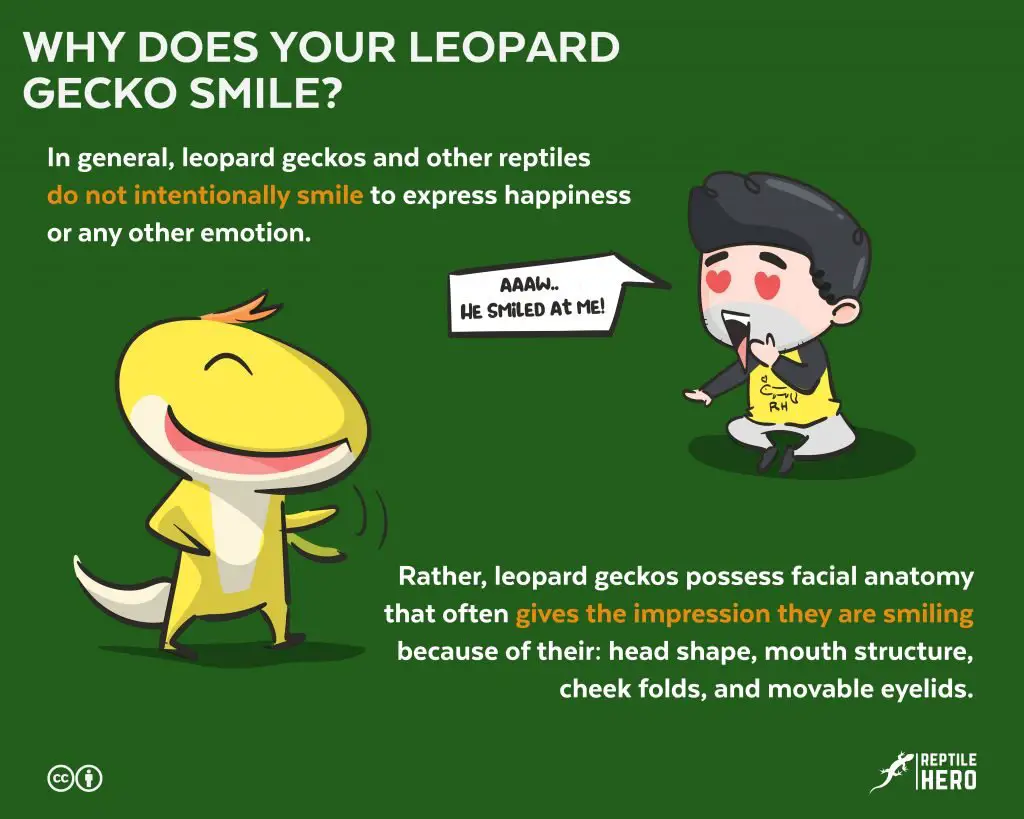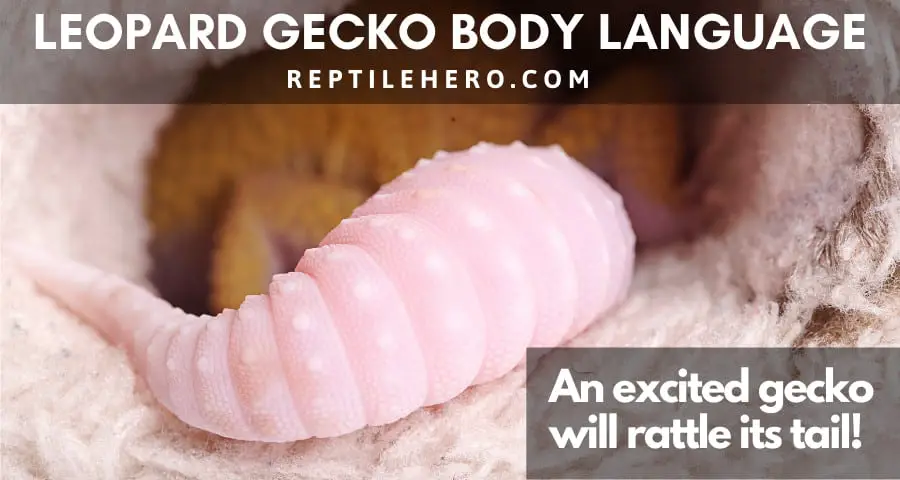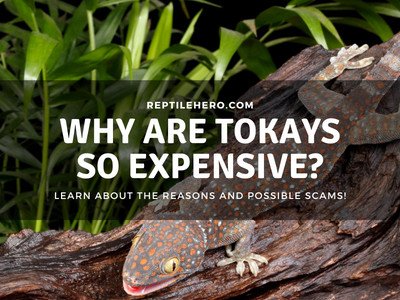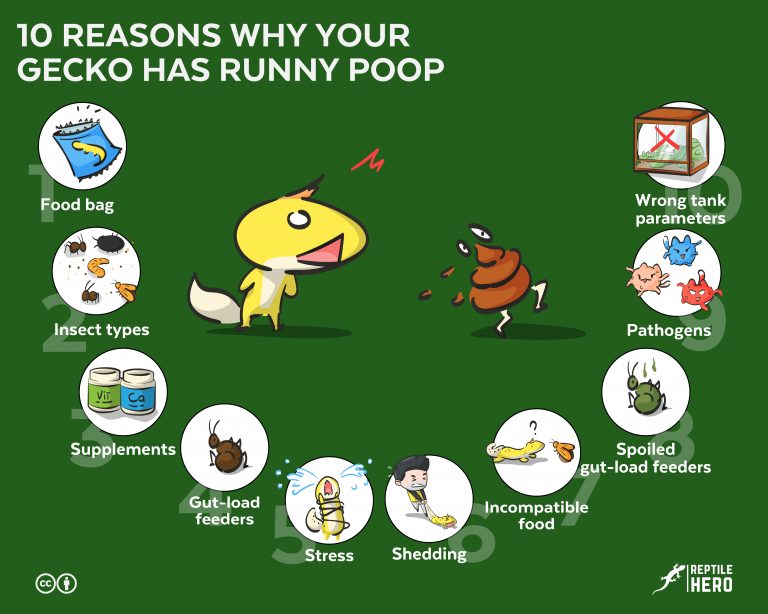Why Does Your Leopard Gecko Smile? (What Science Says)
Smiling geckos—what a feast for the eyes of reptile owners! But can leopard geckos even really smile out of their own free will? What does science have to say about our smiley little geckos? Here’s a clue: they’re born with it!
In general, leopard geckos and other reptiles do not intentionally smile to express happiness or any other emotion. Rather, leopard geckos possess facial anatomy that often gives the impression they are smiling because of their: 1) head shape, 2) mouth structure, 3) cheek folds, and 4) movable eyelids.
Contrary to popular belief, leopard geckos don’t smile out of happiness or contentment. They’re just born with very cheerful-looking faces! But is it possible to tell when they’re actually happy or sad? Find out below!

1. Head Shape
Leopard geckos, and most other reptiles, have angular snouts which give the illusion that their lips are curved into a smile. This smile-like profile of geckos is especially recognizable when looking at their heads straight on or from above.
The mechanics behind the “smiling face” of leopard geckos (Eublepharis macularius) are actually nothing special or surprising upon further inspection. Nevertheless, it further gives them a friendly and approachable look.
Compared to humans who have rounder faces, geckos typically have a triangular heads. Because of this, geckos appear as though they are always smiling, whatever they do. Heck, even a simple yawn makes them look like they’re smiling sleepily!
You could even say that it’s because of their naturally jovial facial features that they are incredibly popular within the reptiles community.
2. Mouth Structure
The mouths of leopard geckos are considerably wide and slightly curved upwards on either side. This gives the impression that they are wearing smiles on their faces. This is true regardless of whether geckos have their mouths closed or open.
Leopard geckos don’t have thin straight lines for their lips. Instead, if you look closely, you will notice that their lips are very faintly curved up at either end. This gives reptile keepers and breeders the illusion that geckos are smiling from ear to ear.
If you’re familiar with different gecko morphs, you will also realize that certain facial coloration seems to highlight their charming lips. You could liken it to when people wear lipsticks—their smiles stand out more because of the contrasting colors.
Does this only apply to leopard geckos? No! In reality, almost all reptiles have a seemingly ever-present smile on their faces.
Blanding’s turtles (Emydoidea blandingii), for example, look like they’re happy all the time thanks to their cutely curved beaks. Even larger and more ferocious reptiles like crocodiles (Crocodylidae) have somewhat smile-like expressions on their sharp-toothed faces because of their natural structure.
3. Cheek Folds
The majority of leopard geckos have some excess skin hanging from their upper lips, accentuating their supposed grins. Such a combination resembles dimpled smiles on humans. These extra loose skin (e.g., cheek folds) in their cheeks are evident when looking at gecko faces from the front and sides.
Who doesn’t like a cute dimple or two? I mean, just look at how precious they are!
Quite honestly, they strongly remind me of my little nieces and nephews with their chubby-looking cheeks. Their smiles are surprisingly similar as well!

But why exactly do leopard geckos have excess skin folds at their cheeks?
The excess skin hanging from their upper lips which extend to their lower lips allows geckos to open their mouths widely without injuring themselves. However, not all geckos have these cheek folds.
Day geckos, for instance, normally do not have excess skin hanging from either side of their faces. So despite having angular heads and wide mouths, these bright green lizards look as though they are only shyly smiling— very reserved and polite.
In comparison, geckos look like they’re always ready to make new friends with their unrestrained ever-smiling faces.
4. Movable Eyelids
For humans, leopard geckos appear as though they are constantly smiling due to their natural facial features, and especially because of their movable eyelids. This is because human beings relate subtly squinted or half-closed eyes with genuine smiles.
What sets leopard geckos apart from other popular gecko species like crested geckos (Correlophus ciliatus), is definitely their movable eyelids. It’s also because of their eyelids that leopard geckos seem capable of producing what scientists call the Duchenne smile.
Named after Guillaume Duchenne, the anatomist who started seriously studying smiles, the Duchenne smile refers to the truly authentic smile of pure enjoyment [1].
The Duchenne smile is characterized by the squinting or squeezing of our eyes—smiles that reach our eyes. Simply put, genuine smiles are believed to trigger muscles (orbicularis oculi) near the sides of our eyes which are responsible for what we all call crow’s feet.
Because of their movable eyelids, leopard geckos appear as though they are smiling out of pure, unadulterated joy when their eyes are partially or completely closed!
However, this is not unique to leopard geckos. All the other geckos in the Eublepharidae family are capable of producing the Duchenne smile—albeit admittedly being totally unintentional. Hence their collective nickname, eyelid geckos.
Below are 6 other gorgeous geckos with movable eyelids:
- African fat-tailed gecko (Hemitheconyx caudicinctus)
- Boettger’s strong-clawed gecko (Holodactylus africanus)
- Cat gecko (Aeluroscalabotes felinus)
- Chinese cave gecko (Goniurosaurus hainanensis)
- Hardwicke’s gecko (Eublepharis hardwickii)
- Yucatán banded gecko (Coleonyx elegans)
Do Smiling Leopard Geckos Feel Happy?
Unlike humans, leopard geckos are not capable of deliberately moving their facial muscles to exhibit a smile. They appear to be smiling because of their natural anatomy. As such, it cannot be discerned whether a leopard gecko is happy or not based on its smiling face.
As much as I would love to say that leopard geckos smile because they enjoy our company and attention, I just can’t. Doing that would simply lead to unnecessary myths about reptiles.
Plus, we have to address the big elephant in the room—do reptiles feel anything at all? Or are they nothing more than the unfeeling, cold-blooded creatures they are usually depicted as?
Are reptiles capable of feeling emotions like other pets (e.g., cats, dogs)?
Several studies provide strong evidence that reptiles do, in fact, experience a wide variety of emotions [2]. More specifically, reptiles can definitively experience:
- Aggression
- Anxiety
- Distress
- Excitement
- Fear
- Frustration
- Pain
- Pleasure
- Stress
- Suffering
Now, is that all there is to reptile emotions? Of course not!
Just a few decades ago, people viewed geckos, snakes, and other reptiles as dumb animals. But science says otherwise. Plus, the interest in reptile emotion, personality, behavior, intelligence, and overall sentience has only gathered steam in recent years.
Learn more about the reptile brain in our article on training geckos.
How Do Geckos Express Happiness or Pleasure?
Geckos may exhibit happiness or pleasure through active exploration of their enclosure, regular feeding habits, and overall calmness.
For humans, smiling is a sign of positive emotions including but not limited to happiness, enjoyment, amusement, and pleasure [3]. But we can’t really guess what our precious little geckos are feeling through their ever-present grins.
So how can we know that they are happy in their tanks with our care?
Honestly, this is a tough question to answer since even experts are not yet a hundred percent sure on the topic. But they theorize that a healthy gecko equates to a happy gecko.

Other interesting behaviors can also give owners a sign of how their pet gecko is feeling [4]:
- Enjoyment: Stick its neck out or move it closer to your touch while handling could translate to enjoyment.
- Calmness: Closing its eyes in your presence may relay that it is calm and relaxed.
- Excitement: Rattling or quickly flicking its tail while eating or during breeding season signals excitement.
Note: Tail rattling should not be confused with the slower action of tail wagging which can be a defensive or aggressive behavior.
Learn more about the body language of geckos in our article on cohabbing geckos.
Further Questions
Can you make a leopard gecko smile for a picture?
Leopard geckos do not intentionally smile, so reptile keepers and breeders cannot force them to smile for pictures. However, taking pictures of a gecko from certain angles (e.g., a tilted angle from above) can accentuate the facial features of geckos which make them look as if they are happily smiling at the camera.
Is it okay to use flash when taking pictures of reptiles and amphibians?
The general consensus for reptile and amphibian photography is that using cameras with flash is safe and advisable in low-light and nighttime conditions. More specifically, captive-bred herps commonly don’t react to the flashing light. However, this is not necessarily applicable to wild reptile and amphibian specimens.
How can you make a gecko feel happy?
Happiness is a construct that is difficult to quantify and measure objectively, especially in reptiles. Hence, gecko keepers and breeders should opt to ensure that their reptiles feel safe and satiated instead of being vaguely happy. To do this, owners must keep up with current studies and updated husbandry standards for their pets.
Do reptiles also have personalities?
Although there is a lack of scientific literature to know for certain, many reptile keepers and breeders believe that their pet geckos and snakes—and reptiles in general—do possess and exhibit distinct personalities. Such temperaments become evident in terms of feeding behavior, overall activeness, and response to people, among other instances.
Can leopard geckos form a bond with their owners?
Current research is still lacking to definitively conclude whether geckos and reptiles in general, are capable of forming bonds with their caretakers. However, many scientists hypothesize that it is possible, and many experienced keepers and breeders echo this sentiment.
Why is it important to know whether reptiles are happy?
Finding out the emotional states, capabilities, and expression of reptiles paves the way for the improvement of welfare and husbandry in the community. This also allows keepers and breeders to better empathize with these cold-blooded animals, which can drastically boost our understanding and attachment to reptiles.
What are the effects of smiling geckos on their owners?
Humans tend to smile when they see others—including pets such as leopard geckos—smile. In effect, gecko owners feel happy and reap benefits. A gecko owner who smiles upon seeing their gecko’s ever-present grin could experience less anxiety, have lower blood pressure, feel their heart rate slow down and normalize, and sustain boosted immune systems.
Summary of Why Leopard Geckos Smile
Leopard geckos, like all other reptiles, do not smile to deliberately express happiness, contentment, or pleasure. In reality, the anatomy of their faces gives the illusion that they are always smiling: 1) angular heads, 2) wide curved mouths, 3) dimple-like cheek folds, and 4) movable eyelids.
However, the inability of leopard geckos to smile does not mean that they do not feel emotions. As a matter of fact, they can feel various emotions—from pleasure and excitement to frustration and anxiety.
Sources
[1] https://www.psychologicalscience.org/observer/the-psychological-study-of-smiling
[2] https://www.ncbi.nlm.nih.gov/pmc/articles/PMC6827095/
[3] https://journals.plos.org/plosone/article?id=10.1371/journal.pone.0226328



![Taking Care of Geckos During Power Outages [Final Guide]](https://www.reptilehero.com/wp-content/uploads/2021/04/Gecko-Care-Power-Outage-768x614.jpg)
![Why Does Your Gecko Lick? [You, Themselves, and Other Objects]](https://www.reptilehero.com/wp-content/uploads/2021/05/gecko-lick-object-cc-768x614.jpg)

